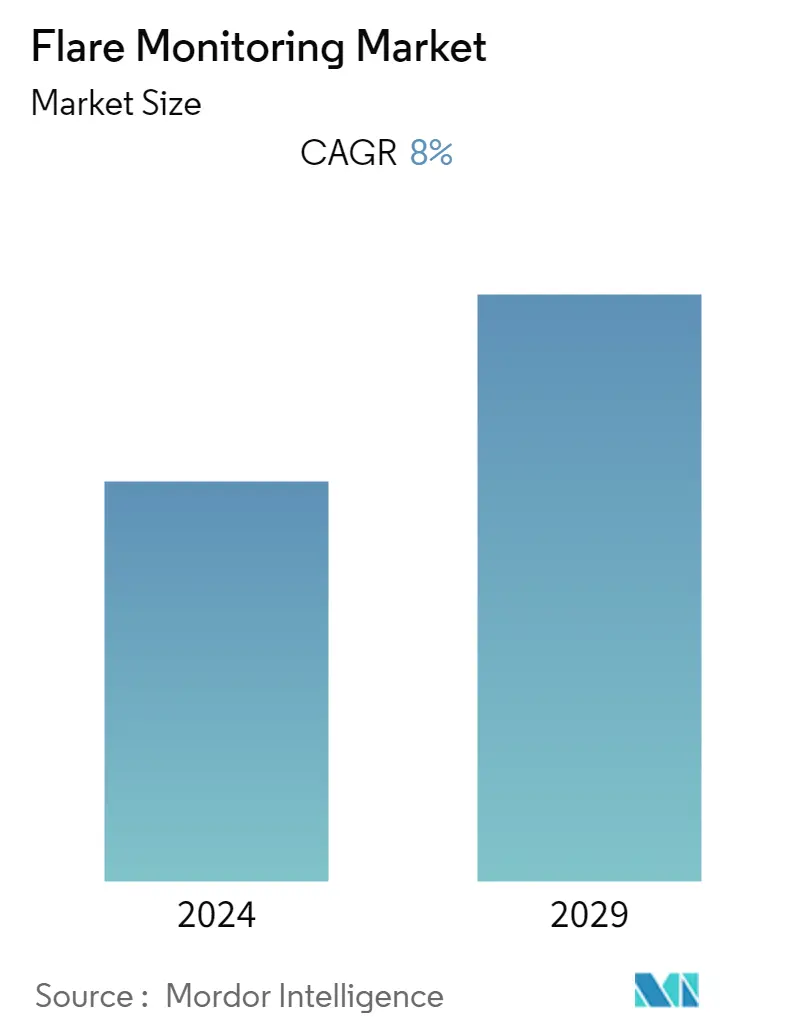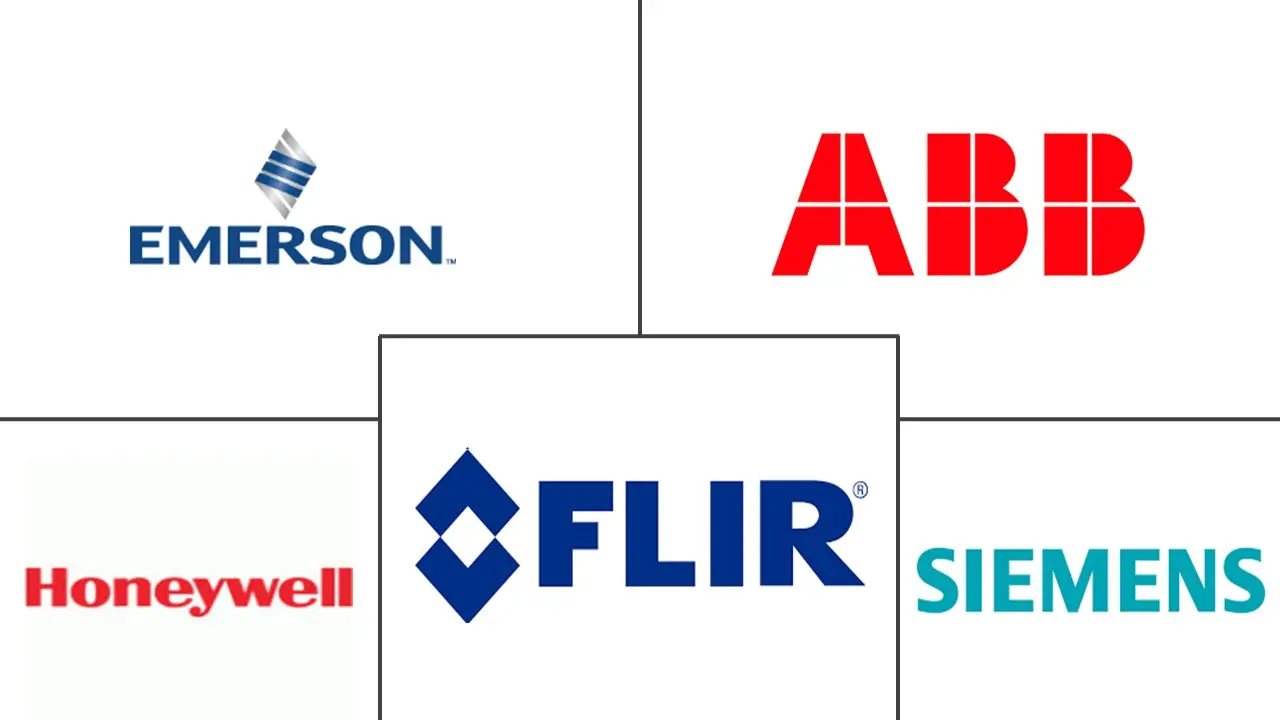Market Size of Flare Monitoring Industry

| Study Period | 2019 - 2029 |
| Base Year For Estimation | 2023 |
| CAGR | 8.00 % |
| Fastest Growing Market | North America |
| Largest Market | North America |
| Market Concentration | Medium |
Major Players
*Disclaimer: Major Players sorted in no particular order |
Flare Monitoring Market Analysis
The flare monitoring market is expected to grow at a CAGR of 8% during the forecast period, 2021 - 2026. The flare monitoring market is expected to grow substantially due to the factors such as strictness in environmental regulations to curb harmful emissions and raise combustion efficiency of flare systems, benefits offered by remote flare monitoring systems, and steady expansion of oil, gas, and petrochemicals industries, especially across the Middle East & Africa and Asia Pacific.
- Moreover, stringent government environmental regulations related to industrial gas emission, requirement of real time flare monitoring system, and requirement of enhanced & increased safety norms & global industry standardization are driving the growth of the flare monitoring market.
- Restricting and controlling the hazardous elements emission in the environment in order to withstand the global environment and avoid the global warming. These factors are fueling the growth of the global flare monitoring system market.However, technical issues resulting from the adherence to restrictive norms while bringing down the global cost of systems is a key challenging factor for the expansion of the flare monitoring market.
- The growing demand from major oil and gas producing countries across the Middle East & Africa and major oil refining countries in Asia Pacific and Europe are offering new growth opportunities to the players in the flare monitoring market. However, governments, oil companies, and development institutions around the world are encouraged to endorse the Zero Routine Flaring by 2030 Initiative which is expected to restrict the market growth.
- Due to the impact of Covid-19 pandemic, many ongoing or new projects across oil and gas value chain are likely to face numerous challenges in terms of project execution, planning and risk management aspect from the pandemic.In the affected region, some of the refinery and petrochemical projects may have been directly impacted due to Covid-19 outbreak .These situations are likely to hinder the market growth of flare monitoring market.
Flare Monitoring Industry Segmentation
The flare monitoring is used to monitor the characteristics of the flare out of the flames from industrial sector and also to restore the gases for environment prevention, for cost saving which can be reused and also helps in maintaining the standardized gases footprints according to the Environmental Protection Agency (EPA).
| Mounting Method | ||||||
| ||||||
|
| End-User | |
| Refinery | |
| Landfill | |
| Petrochemical | |
| Oil & Gas | |
| Other End Users |
| Geography | |
| North America | |
| Europe | |
| Asia-Pacific | |
| Rest of the World |
Flare Monitoring Market Size Summary
The flare monitoring market is poised for significant growth, driven by stringent environmental regulations aimed at reducing harmful emissions and enhancing combustion efficiency in flare systems. The adoption of remote flare monitoring systems and the steady expansion of the oil, gas, and petrochemicals industries, particularly in the Middle East, Africa, and Asia Pacific, are key factors contributing to this growth. The demand for real-time monitoring systems and adherence to enhanced safety norms and global industry standards further propel the market. However, challenges such as technical issues related to compliance with restrictive norms and the impact of the Covid-19 pandemic on project execution and planning pose potential hurdles to market expansion.
North America leads the global flare monitoring market, supported by robust government regulations addressing emissions from industrial activities and a surge in drilling and shale gas exploration. The region's market growth is bolstered by the increasing industrialization and power plant development, alongside the rapid expansion of the chemical and petrochemical industries. The United States, with its strategic focus on becoming a top oil and gas producer, plays a pivotal role in driving demand for flare monitoring systems. Companies in the market are actively seeking to enhance their global presence and product offerings, with strategic investments and partnerships aimed at strengthening their market position.
Flare Monitoring Market Size - Table of Contents
-
1. MARKET DYNAMICS
-
1.1 Market Overview
-
1.2 Market Drivers
-
1.2.1 Stringent Government Environmental Regulations Related to Industrial Gas Emission
-
1.2.2 Expansion of Oil, Gas, and Petrochemicals Industries
-
-
1.3 Market Restraints
-
1.3.1 Initiative of Zero Routine Flaring by 2030
-
-
1.4 Industry Value Chain Analysis
-
1.5 Industry Attractiveness - Porter's Five Forces Analysis
-
1.5.1 Threat of New Entrants
-
1.5.2 Bargaining Power of Buyers/Consumers
-
1.5.3 Bargaining Power of Suppliers
-
1.5.4 Threat of Substitute Products
-
1.5.5 Intensity of Competitive Rivalry
-
-
1.6 Assessment of Impact of Covid-19 on the Flare Monitoring Market
-
-
2. MARKET SEGMENTATION
-
2.1 Mounting Method
-
2.1.1 In-process mounting
-
2.1.1.1 Gas Analyzer
-
2.1.1.2 Calorimeter
-
2.1.1.3 Mass Spectrometer
-
2.1.1.4 Gas Chromatograph
-
-
2.1.2 Remote Mounting
-
2.1.2.1 Multi Spectrum Infrared (MSIR)
-
2.1.2.2 Thermal Imager (IR)
-
2.1.2.3 Others
-
-
-
2.2 End-User
-
2.2.1 Refinery
-
2.2.2 Landfill
-
2.2.3 Petrochemical
-
2.2.4 Oil & Gas
-
2.2.5 Other End Users
-
-
2.3 Geography
-
2.3.1 North America
-
2.3.2 Europe
-
2.3.3 Asia-Pacific
-
2.3.4 Rest of the World
-
-
Flare Monitoring Market Size FAQs
What is the current Flare Monitoring Market size?
The Flare Monitoring Market is projected to register a CAGR of 8% during the forecast period (2024-2029)
Who are the key players in Flare Monitoring Market?
ABB, Siemens AG , Flir Systems, Honeywell International Inc. and Emerson Electric Co. are the major companies operating in the Flare Monitoring Market.

